Let’s start with a broad look at the supply and demand outlook for silver and how this impacts pricing. What are the main factors impacting this?
The supply and demand outlook for silver is exceptionally strong. Global silver demand is forecast to hit 1.2Boz in 2024. That would be the second highest level on record, surpassed only in 2022 at 1.24Boz, according to The Royal Mint. In fact, silver has been in a structural deficit since 2021, and another large deficit of 176Moz is forecast for this year as well. Deficits are expected for years to come.
Silver prices have moved mostly sideways for the past three years, and many are wondering how this is possible. I consider secondary supplies to be those other than from mining and recycling. This is what is found in inventories of futures markets (LBMA, Shanghai, COMEX) silve ETFs, and privately owned bars and coins. I believe recent large deficits have been met by soaking up secondary supplies in futures markets and ETFs. But this supply is limited.
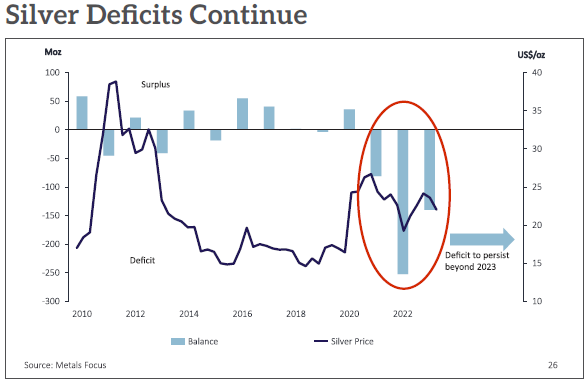
Mine supply peaked several years ago, and we haven’t seen high levels of supply coming to market recently. What’s needed to spur investment into silver?
Bank of America Global Research surveyed the 13 largest primary silver miners. Collectively, they see silver mine supply flat, around 800Moz for the next several years. Mine supply peaked in 2016 at 900Moz and has never approached that level again. And yet, total demand is more than 20% higher today. That tells me that silver miners are struggling to produce more silver but are unable to increase their overall output.
Right now, about 25% of silver comes from primary silver mines. The other 75% comes as a byproduct of mining gold, copper, lead, and zinc. Silver supply is inelastic to demand. So, output from silver mines and from mines that produce these other metals needs to rise. Investment in silver will only come once the prices of all these metals are higher and remain higher for an extended period. That will motivate explorers to find more, developers to finance and build their projects, and producers to expand production. Let’s not forget that it can take as much as 10 to 15 years to bring a new silver mine into production.
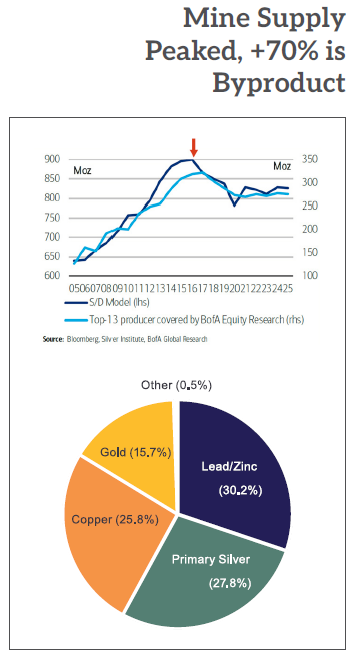
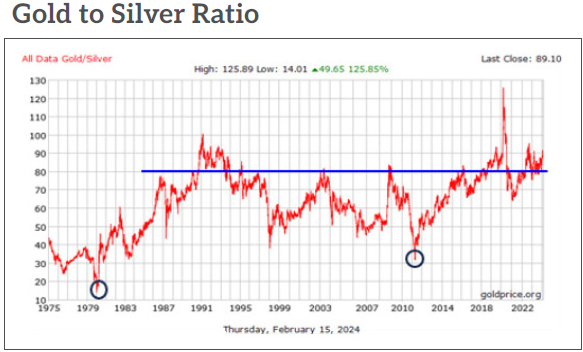
How relevant still is the gold/silver ratio when assessing silver rates?
The gold/silver ratio is only one of many indicators, but it remains useful. It essentially tells us how many ounces of silver are needed to buy one ounce of gold at any given point in time. It’s important to note that the ratio has averaged at a historically high level in the past 40 years, around 60:1. When the ratio is above 80 it suggests that silver has become too inexpensive compared to gold, and the ratio is likely to fall. When that happens, and the silver price is rises, both metals tend to do well. Still, the ratio can also fall if both metals’ prices are falling, but gold prices fall faster than silver prices. So, we need to look at price direction as well as the ratio.
Silver has a growing use as an industrial metal, though it has traditionally been considered more precious. Can you speak about the various uses and demands for silver?
Throughout history, silver’s main use has been as money, jewellery, and silverware. There was also some use in mirrors, health, and medicine. Silver’s use in photography began almost two hundred years ago and became substantial until digital photography gained prominence.
Silver is classified as the best electrical and thermal conductor, and the most reflective material. That makes it not only ideal in many of its applications, but also irreplaceable. As you might expect, silver is found in semiconductor chips, printed circuit boards, CPUs, on/off switches, and a lot more. Thanks to its ubiquitous use in electrical and electronics applications, we are rarely more than a few feet away from silver. But silver’s use in solar has become a huge demand factor.
Overall industrial use has grown from about 50% for decades to 60% of demand recently. The balance of silver demand is made up of jewellery (18%), silverware (4%), and physical investment (22%).
How much is this tied to the energy transition?
The International Energy Agency expects solar to become the top source of energy globally by 2027, surpassing coal and natural gas. In the last decade, silver’s use in solar has soared, quadrupling from 50Moz silver to 200Moz silver, annually. But, the photovoltaics (solar) industry is advancing rapidly, and newer technologies require from 50% to 150% more silver per panel. That really makes solar the 800-pound gorilla, consuming 20% of annual silver supply. So, I expect solar demand to continue growing for years. Silver is also used in EVs, which require twice as much silver as internal combustion engine vehicles.
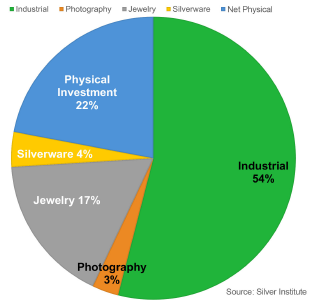
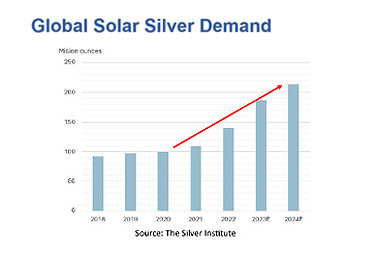
Exploration is a missing piece in boosting supply for key energy transition metals, and silver seems to be no different. Where do you see most of the interest in exploration (and investing in exploration) for silver coming from?
Right now, silver junior explorers are struggling. The silver price has been in a sideways pattern for three years, and many companies are facing serious challenges sourcing capital. Most of the funds they are raising comes from a handful of astute private investors with keen foresight. A few producers are doing joint ventures on attractive exploration projects or acquiring smaller projects or companies outright. Additionally, some juniors have become very creative in raising funds: one has pledged some of its in-ground silver to back an NFT, while another collects royalties on its alluvial gold projects.
What do you think will be the key trigger for the next rally in silver?
Large and growing industrial demand will tend to provide a steadily rising floor under silver prices. But I see investment demand as the wild card, which can cause huge rallies and even spikes.
I think the most likely trigger for the next silver rally, is a gold rally. Silver tends to follow gold with a lag, and I see the current gold strength coming from expected central bank rate cuts. There are several black swans that could also trigger a rally: renewed banking crisis, international conflict, sudden spike in inflation, silver supply shortage, etc.
We could see supplies on the three large futures exchanges and the silver ETFs be drained. It’s very interesting to note that all three exchanges have seen their inventories shrink overall by about 40% over the last three years. But their registered silver, which is what’s available for delivery, is down 70%.
ETFs have seen their inventories down about 40% in the last three years. I think that large consumers, like solar panel and electronics manufacturers are taking delivery of this silver. When that runs out, look out. If a large contract holder who stands for delivery is told there’s no silver left, that will send shockwaves through financial markets. I see this risk as substantial, but not being priced in by the markets, and that’s created an opportunity for those who recognize it.












